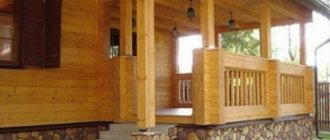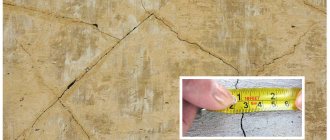What is a load-bearing wall?
This is a partition that serves as a support for floor slabs. The load-bearing wall is installed perpendicular to them. The short side of the slab rests on this partition, which takes on a significant part of the mass and then transfers pressure to the foundation.
Typically, load-bearing (main) structures are external walls and those located between apartments or blocks. Partitions located in the apartments themselves, as a rule, do not carry much load. More often, redevelopment involves the demolition of interior partitions, but not everyone and not everywhere can determine what cannot be touched.
If, during a major renovation, the owners incorrectly identify the load-bearing wall and then begin to get rid of it, cracks will most likely appear in the building. The worst consequence is the collapse of the ceiling. Therefore, without firm confidence in one’s correctness, confirmed by the relevant authorities, no work can be carried out.
Redevelopment - what is it?
Redevelopment is a change in the configuration of an apartment. The Housing Code states that these changes must be made to the technical passport and approved by the relevant authorities. Redevelopment includes moving window and door openings, changing walls and partitions, dividing large rooms, moving a kitchen or bathroom.
Typically, redevelopment is limited to the removal of interior partitions. But you need to know exactly which walls are allowed to be demolished and which ones cannot be touched. Otherwise, demolition may change the impact of forces on the remaining surfaces below, and unsupported ceilings may collapse, unable to withstand the load. Do not forget that the walls not only divide the room into rooms, but also support the ceiling above similar structural elements.
Determination of load-bearing walls by thickness
The second way to find out which wall is load-bearing is by its location and thickness.
Load-bearing walls in a brick house
The thickness of the walls in brick houses is a multiple of the size of the brick (120 mm), plus the thickness of the mortar joint (10 mm), if there is more than one masonry. Accordingly, brick walls can be 120, 250, 380, 520, 640 mm thick, etc. Basically, in brick residential buildings, internal partitions are made of brick or gypsum concrete panels 80 or 120 mm thick. Apartment partitions 250 mm thick made of brick or 200 mm thick made of double panels with an air gap. Load-bearing walls in a brick house have a thickness of 380 mm.
Most brick houses built according to standard series are the so-called “Stalinka” and “Khrushchev” buildings. Both of these types have similar design solutions and are made in the form of three longitudinal load-bearing and transverse walls, which support the longitudinal ones and, basically, are also load-bearing.
Also, the load-bearing walls are the walls on which the interfloor floor slabs rest (short side). Usually these are longitudinal load-bearing walls. There is an option when the floor slab rests on a reinforced concrete beam of rectangular cross-section. Which, in turn, rests on load-bearing walls or brick pillars. Interior or apartment partitions are usually installed under the beams.
Load-bearing walls in a panel house
In panel houses, the thickness of internal partitions ranges from 80 mm to 120 mm, made of gypsum concrete panels. And, internal load-bearing walls are reinforced concrete panels with a thickness of 140, 180 or 200 mm. External load-bearing walls in a panel house have a thickness of 200 mm. Most often these are single-layer panels made of expanded clay concrete with a thickness of 300-350 mm or multilayer panels consisting of two reinforced concrete panels with a thickness of 60 mm (external) and 80-100 mm (internal), separated by insulation. As a result, load-bearing walls in a panel house have a thickness of 120 mm.
How is a load-bearing wall indicated on an apartment plan?
Upcoming repairs, reconstruction, or even the acquisition or sale of an apartment will require the use of technical documentation. The apartment plan created by the builders clearly indicates load-bearing walls. Often on diagrams, supporting structures are marked with a bold, double or simply thick line, which will differ significantly from others.
Important! When figuring out how load-bearing walls are indicated on the apartment plan, it is important to contact a BTI specialist for clarification. Not all main partitions are always marked with thick lines. This most often applies to those located between two apartments or throughout the entire room. Similar partitions may also be present inside it.
In an effort to find out how load-bearing walls are indicated on the apartment plan, you should contact the regulatory authorities. Some cases require calling a specialist to your home to get the most accurate and complete answer.
How to find out which wall is load-bearing in an apartment can be found using the following documents:
- BTI technical passport. It is this kind of document that is more detailed, since it can contain clarifications regarding the main structures, as well as explanations about the year of construction and the selected materials for carrying out such work. It also indicates not only which walls in the apartment are designated load-bearing, but also the parameters of the room.
- Step by step plan. This document is not always able to completely clarify the situation. The presented drawing often does not have explanations, extracts, or clarifications. The plan is simply presented here, and its accuracy will depend largely on the master who compiled it. How to determine the load-bearing wall in an apartment in this case? To clarify, you should use the information that will be provided above - measure the thickness, find out the method of supporting the beams, the location of the partition.
How do you know if a wall in an apartment chosen for demolition is definitely load-bearing? Invite a specialist from BTI if there is no plan. You can go to see him if you have a plan in hand.
Everything is presented much simpler by modern developers. The plan often shows which walls in the apartment are load-bearing. Often the document is presented in color. Here the structure of interest to the owner is indicated in red. The developer himself is often ready to tell you what a load-bearing wall in an apartment means and what function it performs. Some modern layouts are presented in a free style - without a single partition. The secret is that there are no internal load-bearing walls in the room, and therefore reconstruction is easy to carry out.
Load-bearing wall in one-room apartments
How to find out which walls in an apartment are load-bearing if the apartment has only one room? The simplest possible configuration does not require a large number of main partitions. Often a load-bearing wall in a one-room apartment is one that:
- Connects two different apartments - an adjacent panel.
- Separates the living space from the stairs.
- Goes out into the street. If the room is corner, it may have two or more external walls, which will be load-bearing.
How to determine load-bearing walls in a panel house? Often they are no different from those indicated in a block, brick structure.
Load-bearing wall in two-room apartments
Owners of multi-room housing are interested in how to find out whether the apartment has a load-bearing wall or not. It is important to answer this question, since often in their own homes, owners try to increase usable space precisely by demolishing partitions. Serious redevelopment of living space will require clarification. How to find out where the load-bearing walls in a two-room apartment are?
With such housing, not everything is as simple as with one-room apartments. There is often more than one load-bearing wall in a two-room apartment. She:
- Connects different apartments - becomes an adjacent partition. There are as many walls as there are adjacent separate living spaces.
- It can delimit the space of the kitchen and other rooms.
- Often becomes an external wall.
If the rooms inside the apartment are spacious, there may also be load-bearing walls between them, but often this is not the case. That is why it is possible to redesign the internal space of residential premises, connecting them with the corridor, but not with technical rooms. An experienced master who undertakes redevelopment knows exactly how to determine the load-bearing walls in a brick house, monolith or block building.
Load-bearing wall in three-room apartments
If redevelopment is required during the work, a floor plan will be required. It is important to know how to determine the load-bearing wall in an apartment so as not to disturb the skeleton of the entire building. Often treshka is a typical layout of rooms:
- One small one is located separately, and two spacious ones are located not far from each other.
- The premises can be dispersed in different parts of the house.
- There are options that provide for complete isolation of rooms from each other.
- The bathrooms are located nearby, and not far from the kitchen area.
- There may be one or two balconies. Some Czech projects provide a single large balcony for two rooms.
Since there are always many rooms, there is always more than one load-bearing wall in a three-room apartment. This is necessarily the one that serves as a ceiling between two apartments, a landing and goes out onto the street. Some types of layouts also provide main structures between the bathroom, kitchen, and bedrooms.
Load-bearing wall in four-room apartments
If redevelopment is to be done, it is important not to touch the main partition. How to find out where load-bearing walls are located in an apartment? Use the plan to determine the thickness of the structures. In a panel house it reaches 14–20 cm, in a brick house - from 38 cm, and in a monolithic house they may not be there at all. In such rooms, the main panels may be inter-apartment panels, interior panels and those that connect the staircase and living space.
Often, instead of walls in a monolithic house, pylons and columns are used, which can cope with serious loads.
It is also important for owners to take into account the years of construction of buildings. In Soviet times, all buildings were standard, and therefore, in the absence of a plan, you can look into your neighbor’s. But since the beginning of the nineties, individual projects have been used to create residential complexes, and therefore it is impossible to do without measuring the thickness of the walls. It is important to clean them from layers of plaster and other materials before such work.
Panel houses
Partitions in a panel house usually have a thickness of 80–100 mm. It can be made of gypsum concrete. As for the load-bearing wall, it can be 140, 180, 200 mm thick. If, after measuring the wall, its thickness is less than 120 mm, then it is definitely a partition. But note the fact that in some panel houses the walls are plastered. So be sure to take this into account when measuring. Although in most cases the layer of plaster does not exceed 50 mm, which means it will not have a significant impact. But it is best to take the wall thickness as a basis at the point of measurement.
Studio apartment we demolish walls without damage!
In modern designs, small open space apartments called studios are extremely popular. This layout is convenient for a family of 2-3 people. Many people want to remodel large apartments in a studio, dividing the interior space with furniture. This option requires complete or partial demolition of the walls, leaving only the box of the apartment.
It is necessary to understand that such redevelopment requires the creation of supporting structures to distribute the main weight of the upper floors. Many professionals offer clients the use of frame technologies and the creation of decorative columns and built-in niches. This option harmoniously delimits the space and does not violate the requirements of higher authorities of technical bureaus.
Let us remember that the older the structure, the more significant the fragility of the main walls. In old-type buildings, the main structures are not allowed. Therefore, dismantling is prohibited without additional supports and a detailed calculation of the weight of the floors. Masters recommend seeking help from professional architects who will help resolve the issue of redevelopment without additional costs or violations of requirements.
Renovating old-style apartments is always a difficult task, requiring the involvement of third parties. We do not recommend carrying out large-scale demolition activities on your own at one time. Remember that by turning to professionals, you preserve not only your own comfort, but also the comfort of your neighbors.
We recommend watching the detailed installation of the load-bearing wall in the video:
Load-bearing wall thickness
The thickness of the walls may vary depending on the building material from which the building was erected and its design features. If, for example, the house is lined with brickwork, then the minimum thickness of such a load-bearing wall is determined by the number of bricks in one row. If it exceeds thirty-eight centimeters, then the wall is load-bearing.
The thickness of the walls made of expanded clay concrete blocks is generally fourteen centimeters; the dimensions of the load-bearing walls exceed these values and amount to approximately 90 centimeters.
The thickness of walls made of gas silicate blocks depends on their density. With a density of 400 kg/m3, they can be used to build external walls of one-story houses, outbuildings, and utility rooms. The density of gas silicate blocks of 500 kg/m3 makes it possible to use them in the construction of load-bearing walls in the construction of houses up to three floors high. A density of 700 kg/m3 ensures their use in the construction of multi-storey residential and administrative buildings.
As a rule, load-bearing aerated concrete walls are made of blocks 30-40 centimeters thick. We talked more about the sizes of aerated concrete blocks in the article about comparing aerated concrete and foam concrete.
The thickness of wood concrete walls also depends on its density. Wood concrete is a unique material, which can contain up to ninety percent wood chips, so its qualities are close to wood. Wood concrete blocks with a density of less than 500 kg/m3 are used for thermal insulation; a density of more than 500 kg/m3 is structural.
How to determine whether a wall is load-bearing or not: design features
Redevelopment of an apartment involves either the construction of additional walls or the destruction of existing ones. Most often, during this, the walls are destroyed, thereby increasing the living space. Such a radical decision is simply necessary, since this is the only way to expand the home, make it more comfortable; also, with the help of redevelopment, many people connect the kitchen with the living room or enlarge the bedroom due to the loggia. The only problem during renovation is how to correctly determine the load-bearing walls in the house. This information is important, and therefore you need to familiarize yourself with it, which is what we will do in the article.
What is a load-bearing wall?
First, find out what a load-bearing wall is and where it is located. Load-bearing walls perform an important task - they maintain the integrity of the entire structure. Columns and beams sometimes act as load-bearing elements, but this does not change their purpose. Since all elements of the roof and ceiling structure rest on the wall, it is important to know during redevelopment how to determine the load-bearing wall in the house. If you demolish it, it can lead to bad consequences, starting with cracks appearing on the house and ending with complete destruction of the structure. Unlike load-bearing walls, ordinary interior walls support only their own weight and also perform a separating function. To ensure that repair work is carried out safely and correctly, you should contact specialists for help. Only they know how to determine whether a wall is load-bearing or not. Do not forget about the special permit for redevelopment, which is issued by specialists from the technical inventory bureau. It will indicate which walls can be destroyed and modified, and which are prohibited.
Methods for determining load-bearing walls
There are several ways to determine whether a house has a load-bearing wall or not. Accurate and easy to do is to study the structural plan of a house. This document is in the capital construction department. Also, do not forget about the existence of a technical passport. If the apartment owner knows how to read construction drawings, it will not be difficult for him to determine the load-bearing wall in the house.
Load-bearing walls are often determined by their thickness and location. When measuring the thickness of the wall, you must first remove the wallpaper and clean the surface of the old plaster. Only after this can measurements begin. The parameters of load-bearing walls are different for all houses, for example:
The load-bearing walls in a brick house are thirty-eight centimeters thick. The more bricks laid, the greater the thickness.
In panel houses the situation is slightly different. Here, all walls exceeding fourteen centimeters are load-bearing. In such a house, redevelopment is difficult and almost impossible. After all, most of the walls in a panel house are load-bearing.
In monolithic houses, walls thicker than twenty centimeters are load-bearing. In houses, it is quite difficult to determine the load-bearing wall thickness. Therefore, it is easier to take a general floor plan from the developer.
All external walls form the basis of the building, serving as support walls.
Openings
Once the load-bearing walls in the apartment are determined, certain restrictions associated with redevelopment will appear. It is impossible to completely demolish a load-bearing wall. It is better to make an opening or niche in it - this is a safer option. The number of openings in load-bearing walls is limited.
If it is necessary to make an opening in such a design, it is better to seek help from professionals. Carrying out such work on your own is dangerous, and without special permits and papers with the redevelopment done, such an apartment will become a burden.
There are situations when partial demolition of a load-bearing wall is necessary. In this case, you cannot do without an engineer. Even a small window or door opening requires appropriate permits and licenses.
Only true professionals in their field will be able to not only make an opening in a load-bearing wall, but also increase its strength. This will help avoid its destruction. A metal or reinforced concrete lintel is used to support the wall.
Load-bearing walls in a panel house
Most panel houses have a standard code for the project according to which they were built. Therefore, before you begin redevelopment, you need to know how to determine the load-bearing wall in a panel house.
To find load-bearing walls in a panel house, you can use the database of these structures. It makes it possible to see the layout of apartments from each series and choose your home using the code. Another way is to measure the walls. The thickness of self-supporting walls in a panel house ranges from 80 millimeters to 1 meter, while the thickness of load-bearing walls ranges from 140 to 200 mm. The higher the indicator, the greater the likelihood that it is a load-bearing wall. It is important to remember that demolishing it in a panel house will lead to the destruction of the building.
How to find out if a load-bearing wall in a house is made of brick?
To find out how to determine a load-bearing wall in a brick house, you need to add the thickness of the vertical mortar joint to the size of the brick. That is, the thickness depends on how many bricks are supplied. Brick walls can be 120, 250, 380 mm thick, and so on, plus finishing layers.
Load-bearing brick walls have a thickness of three hundred eighty millimeters or more. If self-supporting structures are made of gypsum concrete panels and bricks, then in this case the interior partitions will be 250 mm. Thus, load-bearing walls in brick houses have a thickness of 380 mm. If during measurements the thickness is less than 380 mm, then such a wall is an ordinary partition. Finding brick houses by series is more difficult than panel houses, since there are much fewer of them.
Load-bearing walls in Khrushchev
All Khrushchev buildings were built according to the same type. They have three load-bearing walls and additional transverse ones, which serve as support for the load-bearing ones and prevent them from tipping over. This list also includes the transverse walls of the staircase. They support not only load-bearing structures, but also flights of stairs, thus also becoming load-bearing.
How to determine a load-bearing wall in a brick apartment? Can it be dismantled or not? The slabs that are located between floors are supported by load-bearing or transverse reinforced concrete walls and beams.
If we talk about modern buildings, studio apartments are very popular. In such rooms, many manage without redevelopment, simply dividing the space with furniture. To make a smart home out of an ordinary apartment, you need to completely or partially dismantle the walls, leaving only the box. However, such global changes will negatively affect the integrity of the building, especially if it is old.
How to find a load-bearing wall in a monolithic house?
Are you interested in how to determine whether a wall is load-bearing or not in a monolithic house? These buildings have a variety of architectural and design features. They combine conventional load-bearing walls, columns, beams and rectangular columns. The thickness of load-bearing walls is 200-300 mm, and the thickness of columns in monolithic houses is an order of magnitude higher. All walls having a thickness of less than 200 mm are considered partitions.
When it comes to new buildings, the load-bearing structures are easy to determine simply by inspecting them. They are clearly visible because they are made of reinforced concrete. Holes sealed with mortar can also be seen on the load-bearing walls.
What can you do with a load-bearing wall?
As is already known, the structure is the basis of the building and holds the main load; it must be handled carefully and carefully. Before determining whether a wall is load-bearing or not, it is worth finding out what actions are prohibited in relation to it:
It cannot be completely demolished, as this will affect the stability of the entire structure.
It is prohibited to move it to another place.
It is prohibited to install wiring or conduct communications in it.
Despite these prohibitions, a load-bearing wall is not untouchable; you can make a doorway in it, create an arch or partition between rooms, or drill through it.
How to coordinate redevelopment
Before carrying out redevelopment, it is necessary to obtain permission from the relevant authorities. Since residents do not always correctly determine the type of wall covering or dismantle the load-bearing wall, these approvals are mandatory. Therefore, the question of how to determine a load-bearing wall according to the building plan can play a bad joke with residents.
Do not neglect the rules, otherwise the construction will become illegal and the owner will be fined. It follows from this that it is better to spend time on official authorities and obtain all permissions than to suffer from mistakes made.
If you are deciding whether to redevelop a room or not, you should remember that even a harmless error in calculations when performing this work can provoke serious problems. By doing this, you risk your life and the lives of other household members.
Since it is not always possible to determine the type of load-bearing wall, it is better to use the services of a specialist. Nevertheless, having decided to do the work yourself and knowing how to determine where the load-bearing walls are, be extremely careful and vigilant, because you already know what a possible deviation in calculations or reasoning regarding the type of wall covering and its nature entails.
will take care of your concerns regarding the development of the redevelopment project and its approval. Services for examining load-bearing structures will cost the customer from 2000 rubles. Development of a redevelopment project from 2500 rubles. The service for coordinating redevelopment starts from 10,000 rubles.
The most profitable option for the customer is to order a package of works, which will include the entire range of services for designing and coordinating your redevelopment.
Ideas for designing openings in a load-bearing wall
It is prohibited to completely dismantle a load-bearing wall. However, when creating openings, there are options for decorative filling of load-bearing structures. One of the stylish proposals of designers is the formation of an aquarium system on part or the entire wall.
Options for placing aquariums between load-bearing columns:
- The aquarium in the space between the column and the additional interior partition looks stylish and decorates the apartment attractively.
- The addition of furniture with an emphasis on the aquarium system fits harmoniously into the design.
- When expanding an apartment due to the space of a balcony or loggia, window sill systems in the form of aquarium stands are often used. The built-in aquarium looks amazing and captivates the eye with a living picture.
- Built-in aqua systems in niches of load-bearing walls look great in bedrooms and living rooms.
Knowing all the rules, it is easy to determine which wall is load-bearing and planning further design will be easier with the involvement of craftsmen. The InnovaStroy company carries out turnkey repair work of any level of complexity in apartments, houses and offices. Planning and redevelopment of buildings does not cause difficulties for craftsmen. In addition, clients are offered innovative developments and improved comfort of living in an apartment. The company’s specialists make the client’s stay comfortable, and the list of repair work does not cause difficulties. If the question arises of how to determine whether a load-bearing wall is or not, it is necessary to determine the type of structure and know its features.
Does a monolithic house have a load-bearing wall?
Naturally, even in a monolithic house there are certain parts of it that are subject to a more serious load than the rest.
Due to the fact that monolithic houses do not have any standard options and are unique buildings in all their forms, you will encounter a problem that only the author of the building can solve. In any case, if you are planning a redevelopment, you need permission from certain authorities that will give the go-ahead for the demolition or deformation of any walls in your apartment.
How to find out which wall is load-bearing in a Khrushchev building
Khrushchev buildings have the same construction plan, so determining the required wall is easy. You just need to know that in such houses, load-bearing structures include all external walls, and inter-apartment surfaces, as well as surfaces facing the landing.
But, to be sure, you can also focus on the thickness; all surfaces on the inside that are thicker than one hundred and twenty millimeters are load-bearing surfaces.
Which walls can be demolished in a Khrushchev building, the answer is those that are thinner than this indicator can be eliminated. But it is not advisable to touch the dividing wall between the balcony and the room. After all, it was erected so that excess cold did not enter the room. Such a project will not receive permission from the authorities responsible for this issue.
Another way to note is the use of surface drilling; ordinary walls can be easily drilled, but load-bearing walls will be broken by drills.
How to distinguish a load-bearing wall from a non-load-bearing one
So, there are several methods that can be applied in certain cases, these include:
- Studying the documentation received from the BTI is not an easy process, given the fact that you need to have knowledge in this area, otherwise you can easily make a mistake. And in such a matter, a mistake can be fatal. It is better to turn to professionals;
- The tapping method has not been described previously; it involves determining the type of surface, focusing on the sound it produces when tapping on it. Of course, such a technique hardly meets the reliability parameter. After all, some walls, even not being load-bearing, can emit a sound similar to them;
- determining a wall by its thickness. We should not forget that finishing also makes adjustments to the thickness of the surface; the correct measurement will be the surface cleared of finishing materials. For each type of structure, which differs in the materials from which they are built, there are specific standards for the thickness of such surfaces. They are described above;
- drilling a wall to understand how thick the surface is, or even the material and its reaction, a drill can tell what type the surface is.
Of course, particular moments can also make adjustments to the correctness of the surface definition.
Drilling into a wall to understand how thick the surface is, or even the material.
How to find out for sure the load-bearing wall in an apartment?
If there are doubts about the location of the load-bearing structures of an apartment (non-residential premises), and the available BTI documentation, where, as a rule, the load-bearing wall is shown (according to the size on a scale) as thicker, does not give a clear answer, you need to contact specialists.
Making your own decision about the possibility of constructing an opening in load-bearing walls is not only illegal, but is fraught with serious consequences, where the most minor would be a fine and elimination of violations at your own expense.
To approve the redevelopment, it is necessary to provide the housing inspection with project documentation developed by an organization that has the right to do so (SRO approval).
In our organization you can get advice from experienced specialists for free .
You can also order design documentation from us and services for its approval by state control and supervisory authorities.
What is needed to change a wall
Before changing (demolition, moving, etc.) any structure in the apartment, you must consult with a qualified specialist. It is also necessary to perform a full calculation that takes into account the distribution of loads after changes are made. In some cases it is necessary to change the electrical circuit. The redevelopment project must be approved by the government agency responsible for the architecture of the building. For approval you must:
- The plan developed by the BTI service is precisely for this type of redevelopment.
- A technical report was drawn up for changing the wall.
- Availability of a positive decision from the housing inspection at the place of residence.
When planning a major renovation of an apartment, the owner, first of all, should know whether he has the right to make changes to the premises without permission from the relevant housing authorities. In exceptional cases, the housing inspectorate may grant permission for such work. But in any case, it is better to order a professional engineering survey to make a decision whether it is worth changing the design or not.
What actions can be performed with load-bearing walls?
As mentioned above, the structure that bears the main load is the basis of the entire building. Therefore, it must be handled with extreme care. To begin with, let’s outline those actions that are unacceptable to perform in relation to a load-bearing wall:
- demolish, as this is fraught with loss of stability of the entire building,
- move to another place - for the same reasons as in the previous paragraph,
- groove under wiring or pipes.
But still she is not completely untouchable. For example, you can:
- make or expand a doorway,
- drill, including through, if the hole has a small diameter.
It should be taken into account that openings can be made and expanded only after official approval from the administration. And when drilling, you should first determine whether there is wiring inside the wall. Otherwise, you may hit the drill directly into it, which could result in serious injury to you and loss of power to the apartment.
How to distinguish partition walls from load-bearing ones in your apartment: tips
- In brick houses, partitions from three hundred and eighty millimeters thick are considered elements that determine the integrity of the object.
- In buildings made of panels, where the walls are one hundred and forty millimeters or more thick, they are loaded elements.
- In rooms made of monolithic concrete, two hundred or more millimeters of thickness means the structure is recognized as accepting pressure.
- If the ends of the floor slabs lie on the wall, it is classified as a load-bearing structure.
- The partition between adjacent apartments belongs to the loaded part.
- Common to the staircase and apartment, it also transmits pressure from above.
To begin changing the layout of the apartment, you need to determine which structural parts of the room will undergo deformation or transfer. Then, with the help of specialists, decide whether structures important for the safety of the structure will be affected.
This is most relevant in houses assembled from panels, where the breakdown of one part of the house can lead to irreversible, sometimes tragic, consequences. Prior to the start of reconstruction, preliminary coordination with municipal authorities and architecture departments is required. It should be understood that unauthorized changes in the layout of a multi-storey residential building will lead to consequences in the form of:
- refusal to register changes;
- the impossibility of subsequently making any transaction with an apartment that has undergone redevelopment, even if the elements of a multi-storey building that are critical for the integrity are not affected.
In any case, the redevelopment will have to be registered with the relevant authorities. During the reconstruction process, it may be necessary to transfer communications, so it is better to immediately contact specialists before carrying out construction and installation work. Unauthorized redevelopment with the removal of the structure that transmits the load from top to bottom will be impossible or very difficult.
The goals are clear, the decision has been made
Scrolling through numerous Internet sites, you have probably repeatedly come across a variety of videos and photographs that show how easily part of a wall, or a fragment of it, can be removed in order to at least visually expand Khrushchev’s little rooms and give them a more or less bearable appearance in spatial terms. And if you add modern decoration to this, then the desire flares up on its own.
We also prepared materials on redevelopment, but in each material we referred to the fact that the load-bearing wall is inviolable. Now it is time to determine the degree of this immunity and the procedure for determining the load-bearing capacity.
So, you can determine a load-bearing wall:
- According to the thickness of the brickwork;
- According to the technical documentation of BTI;
- With permission from the architecture department of the locality in which you live;
- According to the consequences of rash actions.
A few words about thickness
- The thickness of any wall is calculated in brick parts from half a brick to three bricks . In the language of numbers, half a brick is 120 mm, and a full brick is 250 mm. When constructing buildings, calculations are also made for connecting seams, which according to standards are 10 mm. If you come across a 120 or 250 mm brick wall, then these are usually partition walls or partitions made from bricks. They do not carry a significant load, but one should not rush to conclusions. Load-bearing brick walls were usually built from 380 to 640 mm, depending on the climatic region in which the structure was erected. Thus, the minimum thickness of a load-bearing brick wall will be 380 mm, or one and a half bricks. Do you remember? Not a fact.










